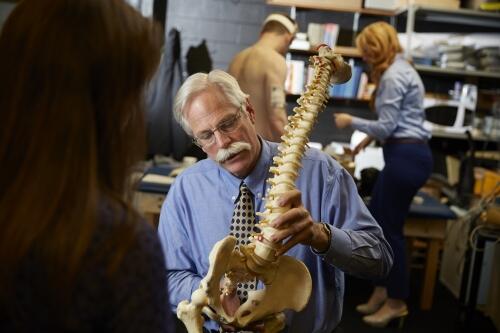
Back pain killing your sex life? Groundbreaking study reveals best positions to save your spine
Contrary to popular belief, spooning is not always the best sex position for those with a bad back.

Contrary to popular belief, spooning is not always the best sex position for those with a bad back.
By Media RelationsContrary to popular belief, spooning is not always the best sex position for those with a bad back, according to new research from the University of Waterloo.
For the first time ever, scientists have successfully documented the way the spine moves during sex and discovered exactly why certain positions are better than others when it comes to avoiding back pain.
“Any family doctor will tell you that couples often ask them how to manage their back pain during and after sex. Many couples will remain celibate because one night of love-making can lead to months of back agony,” said Professor Stuart McGill, of Waterloo’s Faculty of Applied Health Sciences. “Until now, doctors have never had any hard science to base their recommendations upon.”
The pioneering study combined infrared and electromagnetic motion capture systems – like those used in the creation of video games – to track how 10 couples’ spines moved when attempting five common sex positions. The findings were used to create an atlas, or set of guidelines, that recommends different sex positions and thrusting techniques based on what movements trigger a patient’s pain.
“Before now, spooning was often recommended by physicians as the one position that fit all. But as we’ve discovered, that is not the case,” said Natalie Sidorkewicz, a PhD candidate at Waterloo and lead author on the paper. “Sex positions that are suitable for one type of back pain aren’t appropriate for another kind of pain.”

Professor Stuart McGill demonstrates the motion of the spine during sex. ![]()
The atlas recommends that men who are flexion-intolerant – meaning those whose back pain is made worse by touching their toes or sitting for long periods of time, for example – replace spooning with doggy-style sex. The guide recommends that these men use a hip-hinging motion rather than thrusting with their spines.
“For the first time ever, we now have very solid science to guide clinicians on their recommendations for patients who suffer debilitating back pain, but still want to be intimate,” said Sidorkewicz. “This has the potential to improve quality of life – and love-life – for many couples.”
According to Statistics Canada, four of every five people will experience at least one episode of disabling low back pain in their lifetime. Up to 84 percent of men with low back pain and 73 percent of women report a significant decrease in the frequency of intercourse when suffering back pain.
The study also shed light for the first time on the mechanics of the male orgasm. Electrodes hooked up to the male participants' muscles revealed that it is abdominal and buttock, not back muscles, that are most active during orgasm. Spine motion, on the other hand, varied with the individual. For some males, a drastic increase in flexion or extension was seen, while for others spine motion did not change much at all.
"Many of the back pain patients that we see have told us that they experience elevated levels of pain during orgasm, to the point where they will avoid having one during sex with their partner," said Sidorkewicz. "These initial findings help us to begin to understand what might be provoking their pain during the moment of climax."
A paper documenting male spine movement was published on September 10, 2014 in the journal Spine. Female findings are expected to be published in the coming months. The next phase of the study will involve recruiting patients with hip pain and additional categories of back pain to further develop the guidelines.
In just half a century, the University of Waterloo, located at the heart of Canada's technology hub, has become one of Canada's leading comprehensive universities with 35,000 full- and part-time students in undergraduate and graduate programs. Waterloo, as home to the world's largest post-secondary co-operative education program, embraces its connections to the world and encourages enterprising partnerships in learning, research and discovery. In the next decade, the university is committed to building a better future for Canada and the world by championing innovation and collaboration to create solutions relevant to the needs of today and tomorrow. For more information about Waterloo, please visit www.uwaterloo.ca.
-30-
Nick Manning
University of Waterloo
519-888-4451
226-929-7627
www.uwaterloo.ca/news
@uWaterlooNews
Attention broadcasters: Waterloo has facilities to provide broadcast quality audio and video feeds with a double-ender studio. Please contact Nick Manning on 226-929-7627 for more information.

Read more
TRuST Scholarly Network hosts conversation on charting a course through climate misinformation to promote informed climate action

Read more
Brian Orend brings a philosopher’s perspective on happiness, navigating the challenges of chronic illness through connection to ourselves and others

Read more
After a breast cancer diagnosis during the pandemic, Kellie Chouinard turned to social media for support. Learn how this experience shaped her groundbreaking research.
The University of Waterloo acknowledges that much of our work takes place on the traditional territory of the Neutral, Anishinaabeg, and Haudenosaunee peoples. Our main campus is situated on the Haldimand Tract, the land granted to the Six Nations that includes six miles on each side of the Grand River. Our active work toward reconciliation takes place across our campuses through research, learning, teaching, and community building, and is co-ordinated within the Office of Indigenous Relations.